Shoulder Separation in Depth
AKA: AC Joint Sprain, Acromioclavicluar Joint Sprain
| Common Signs & Symptoms | |||||
| Pain | Swelling | Stiffness | Weakness | Instability | Locking |
Shoulder Separation Injury Explained
A ‘Shoulder Separation’ is a common shoulder injury in sports and produces immediate shoulder pain. The term Shoulder Separation refers to an injury of the ligaments at the Acromioclavicular (AC) Joint. The AC joint is part of the shoulder complex. It is situated at the outside point of the collar bone where it attaches to the front of the shoulder blade. The joint is kept stable by four ligaments: the Acromioclavicular ligament, the Coracoacromial ligament, the Trapezoid ligament and the Conoid ligament.
The AC joint ligaments are most commonly damaged through a fall onto the tip of the shoulder, although in collision sports this force may come from an opponent. The impact forces the shoulder blade down and stretches the ligaments away from the collar bone. The Collar bone and Shoulder Blade become separated, hence the term ‘Shoulder Separation’.
There are 3 basic types of injury:
- If the force is not great, a Type 1 injury will occur, in which there is only a mild sprain of the ligaments.
- With more force, a Type 2 injury occurs. This is a more severe sprain and the AC joint is slightly separated but still intact .
- The most severe injury is the Type 3 injury, in which the ligaments of the AC joint are ruptured and there is a dislocation. In this situation, the collar bone becomes loose and can come to rest in several unorthodox positions.
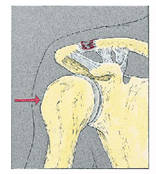  |
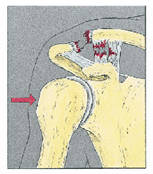  |
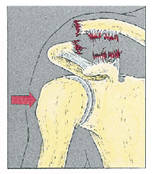  |
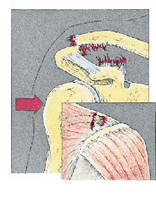  |
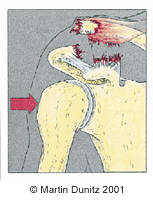  |
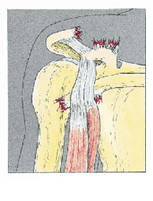  |
Shoulder Separation Signs & Symptoms
Most obviously, there is pain and tenderness on the outer part of the collar bone. This shoulder pain is made worse by shoulder movements. The injured person will instinctively cradle the affected shoulder and try to keep it still. If there is a Type 3 injury, the outer part of the collar bone may be sticking upwards and producing a visible lump. An x-ray should be taken to confirm the diagnosis. This will reveal the degree of separation within the AC joint.
Shoulder Separation Treatment
What you can do
| Consult a sports injury expert | |
| Apply ice packs/cold therapy | |
| Use resistance bands for strengthening exercises | |
| Wear a shoulder support for reassurance |
In the acute stage of the injury pain-relieving medication is helpful. Ice Packs should be applied to the injured shoulder for 20 minutes every two hours (never apply ice directly to the skin). The Ice Packs relieve pain and reduce bleeding in the damaged tissue. The Aircast Cryo/Cuff is the most effective method of providing ice therapy and is the professional’s choice for shoulder injuries. It can provide continuous ice cold water and compression for 6 hours and significantly reduce shoulder pain and swelling.
A Chartered Physiotherapist can apply a taping technique, which will push the collar bone downwards, and the shoulder should then be placed in a sling and rested. Whilst the shoulder is in a sling it is important to keep the fingers, wrist and elbow mobile by going through their full range of movement every four hours or so. Strengthening exercises using Resistance Bands can be started so long as there is no pain.
In the case of Type 1 injuries, the symptoms usually subside in 7 to 10 days and the sling should then be discarded. Gentle pendulum exercises for the shoulder should be initiated and the range of movement in the shoulder should be gradually increased within the limits of pain. Heavy lifting should be avoided until there is full painless range of movement in the shoulder and the tenderness has subsided.
The treatment for a Type 2 injury is similar, but the sling will have to be worn for about two weeks. After a week gentle range of movement exercises should be started. Twice a day the sling should be removed to perform these movements within the limits of pain. The shoulder should be used as normally as possible for washing and dressing activities, but contact sports and heavy lifting should be avoided for at least 6 weeks. Many people find that a Neoprene Shoulder Support is useful following a Shoulder Separation injury.
Shoulder Separation Prevention
Because of the traumatic nature of Shoulder Separation injuries there is not a lot than can be done to prevent them. In collision sports, such as rugby league and American Football, shoulder pads should be worn to reduce direct contact to the tip of the shoulder.


